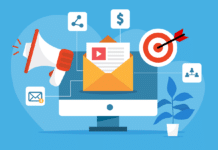Do you think that a CRM and marketing automation system can do the same thing? Well, you’re wrong. While these two systems are both used for lead generation and nurturing, they have different purposes, features, and uses. In this article, we are going to explain how these two systems can work together for better results than when used separately.
What Is Marketing Automation?
Marketing automation is a set of software and tools that automate marketing tasks. It can help you create leads, nurture them, and close more deals. It can be used to manage customer relationships by automating your marketing processes.
For example, if a new customer fills out a form on your website–say they’re interested in learning more about your products or services–you might want to send them an email thanking them for filling out the form and offering additional information about what you offer (this is called lead nurturing). With marketing automation software, this process happens automatically when someone fills out a form on your site: You create an automated email sequence that sends messages based on certain actions taken by users, such as visiting certain pages or subscribing via email newsletter sign-up forms; these are called triggers because they trigger emails based on certain criteria being met (like visiting specific pages).
Why Use a CRM and Marketing Automation?
CRM and marketing automation tools can help you manage your leads and nurture your prospects. They help you generate more leads, improve sales and marketing processes, and are especially useful when used together.
The key benefit of using a CRM (customer relationship management) system is that it allows you to track all the interactions that happen between your company and customers in one place. This includes things like emails exchanged between customer service reps, phone calls made by salespeople, or even tweets sent out by social media teams on behalf of the brand.
Marketing automation software enables businesses to create automated email campaigns based on specific actions taken by prospects or customers (like visiting certain pages on their website). For example: If someone signs up for an e-book offer from our site but doesn’t complete payment within 24 hours, then we’ll send them an email reminding them about their purchase commitment along with links back into our website where they can complete payment easily if needed.
CRM and Marketing Automation Benefits
The benefits of CRM and marketing automation include:
- Better understanding of your customers. The more you know about your customers, the easier it is for you to keep track of their needs, wants and preferences. This allows for a more personalized experience with every interaction.
- More efficient lead management. The automation tools in this category help eliminate repetitive tasks so that salespeople can spend more time on other activities that are more important or interesting to them, like closing deals or generating new leads through social media outreach campaigns (which we’ll talk about later).
- Improved customer experience across the board–from initial contact all the way through purchase/usage! With these solutions in place, businesses can deliver superior service while freeing up valuable resources needed elsewhere within an organization’s structure (like sales reps).
How to Use a CRM to Manage Customers
If you’re using a CRM, it’s likely that you’re using it to manage all of your customers. A CRM is a tool for managing customer data and interactions. It can be used to manage marketing campaigns, sales processes, and customer service activities. You can also use a CRM to organize contacts into groups based on how they are related (i.e., if they share the same address) or their role within an organization (such as being an employee). This allows you to easily track and measure your marketing efforts by filtering through these groups rather than searching through every single contact individually–and this will save time!
If someone has been contacted by multiple people within an organization over time (for example: an account executive making calls every day), then there may be no need for additional outreach unless something changes in the relationship between those two parties (like when one party leaves). However, if there is no recent activity then marketers should assume nothing has changed about their relationship with that person, so any future communications should focus on providing value rather than selling something new again.
How to Use a Marketing Automation Tool to Generate Leads and Nurture Prospects
The first step to using a marketing automation tool to generate leads and nurture prospects is to set up your lead capture forms. By creating a landing page or pop-up form, you can capture information from prospective customers that may be interested in what you have to offer.
The next step is to create an email drip campaign that sends emails based on how users interact with the content they’ve provided on the website. For example, if someone fills out a form but does not provide payment information or sign up for any kind of newsletter or special offer, then follow-up emails will be sent asking them if they need any assistance completing those steps. These follow-up emails can also include reminders about upcoming events or promotions related to the product being offered by your business so that people don’t forget about these opportunities for long periods of time until they are forgotten completely!
The Right CRM for Agencies Can Help You Improve Your Lead Generation and Nurturing Efforts
CRM (customer relationship management) software is used to manage the interactions that occur between a business and its customers. It’s an essential tool for businesses of all sizes, but it’s especially useful for companies with multiple teams or departments that need to collaborate on customer-facing tasks like sales, marketing and support.
The use of CRM software for agencies like Function Point has exploded over the past decade as more businesses realize its value in tracking leads through the sales funnel–from initial contact through closing deals–and beyond into post-sale follow-up activities such as upsells or cross-selling other products/services.
Conclusion
If you’re looking to improve your lead generation and nurturing efforts, a CRM and marketing automation tool can be a great investment. They allow you to easily manage customer information, track sales leads and create targeted marketing campaigns. They also help streamline data entry tasks so that you can focus on other important things like communicating with customers or managing other operations within your agency or organization.





